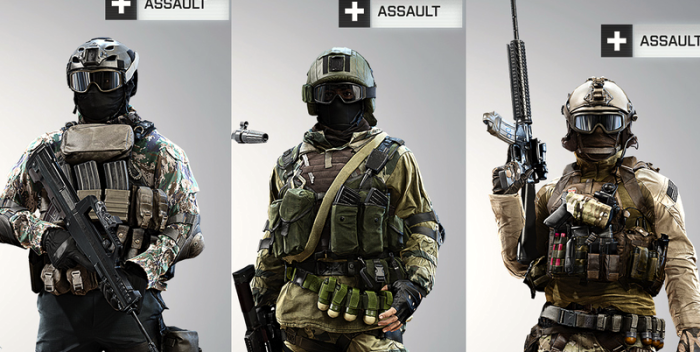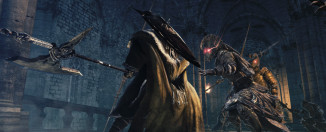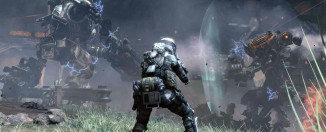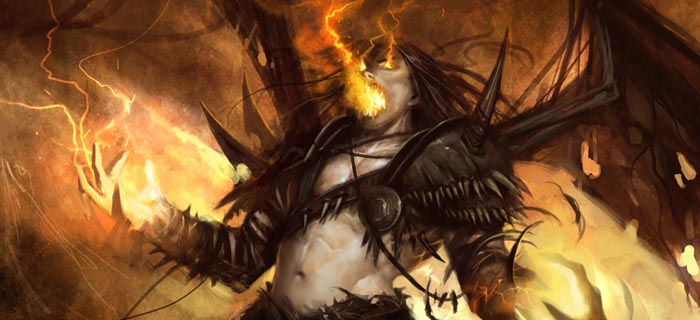Battlefield 4 class guide: assault class basics, part 1
The assault class has always been the standard by which the rest of the Battlefield games are set. In Bad Company 2, they were neither vehicle or infantry centric, instead focusing on a balance between both worlds. Battlefield 3 saw the Assault becoming the Medic class, removing their ability to proactively counter vehicles in trade for an unlimited supply of medkits and revives. Paired with the best overall weapon class, the apt assault rifle, it’s no wonder the class took something of a nerf in BF4. Granted, assault is still perhaps the best overall class, but it now faces stiff competition when it comes to utility.
This article covers the basics you need to know when playing the assault class, and is part of a larger guide that will eventually extend to each class in its turn.
Your assault rifle: simply the best there is
No other weapon class offers the same consistency, range, and damage potential as the Battlefield 4 assault rifle. While they’re beat up close by PDWs, can’t lay down fire like an LMG, and don’t have the range of DMRs or sniper rifles, taking the wide view ARs destroy these weapons in all but their most specialized role. In this respect, the assault’s weapons are jacks of all trades, masters of none. Individual members, like the FAMAS or AEK-971, compete with submachine guns; the SAR-21 and AK-12 are masters of ranged combat. All four have the exact same damage profile, and their difference is in how they handle.
The trick is that handling. Where the powerful SCAR shoots slow but hits hard at almost any range, the FAMAS shoots fast and melts people up close. Like their RPM, the weapons’ recoil patterns couldn’t be less alike, and it’s that trait that differentiates between ARs. There are jackhammers at a distance and shredders up close, and none of them feel too similar to any of the others. Sometime’s it’s even hard to tell that every AR — besides the SCAR — deals 25-18 damage. Your preferred weapon is likely to be either on the extremes or dead center, but each player is different and there are enough assault rifles to accommodate player types.
Short of reading a statistics rundown here, you’d be better served delving into the Symthic charts, the most in-depth weapon analyses on the web, free of player opinion and hearsay. Pulled directly from the Battlefield 4 game files, with DICE’s permission, you can use the info on Symthic to decide which weapon is “the best” without having someone tell you in writing or in a video. ARs might be the best overall weapon class, but which individual weapon a player favors is up to them.
The most important fact that makes the ARs the best overall weapons in the game is that they come on the assault class. By far the easiest class to rack up points with and level on, assault players don’t ever need the total support of their team to be effective. Having it is nice, but all it takes to revitalize an objective push is a pair of defib paddles and some judiciously placed medkits/40mm grenades. Where any other class would need to spend 30 seconds healing, assault players with medic bags only need about 5-10 seconds. If the other classes want to compete in versatility, they need to use the shorter-ranged carbines. The only reason an assault player might need to stop pushing is when he runs out of bullets, but the class is popular enough that you’re liable to find at least one among your dead foes.
Your healing powers: make your team untouchable
The assault class isn’t marked by a medical cross for no reason. Armed with medic bags and defibrillators, you can single handedly bring your team from the brink of failure to the edge of success. DICE has put a hard limit of three revives per assault player, any assaults you revive could have an additional three. Remember also that medkits have an affect radius — once deployed, they work on their own, leaving you free to continue the push.
In the likely event you find yourself alone and unseen by your enemy, any engagement is bound to draw attention. Other classes might not consider engaging, but with your healing abilities, you can give and take damage with impunity, always ready for the next fight. Like revives, a constantly healed assault player can punch holes in defensive lines with greater freedom than a support player and more utility than an engineer or recon. The issue in positioning.
To maximize your effectiveness as an assault, you should always be close to the action. Let the recons flank with their motion balls. Let the supports hold down already-taken choke points, and allow the engineers free reign in their explosive exploits. Your job is twofold: keeping your allies healthy and making slow, consistent progress through the enemy position. Keep tabs on your minimap — don’t hesitate to press “M” on PC to make it bigger — and make sure you’re always in a big mess of green and blue dots. You’ll maximize your own point totals, and make everyone very happy to have you on the team.
When healing’s not an option
For those more in favor of explosives or non-medical support, the assault class comes with a variety of grenade and under barrel attachments to complement your assault rifle skills.
The first are 40mm grenades of the explosive/flash/smoke variety. Of these, you have access to the first from the start of play, and while not as effective as an RPG at destruction, they are still good for taking down well defended buildings and softening up enemies for your teammates. Sufficiently powerful against infantry without being instant kills from any range, 40mm HE is best used in a supportive role, using the arcing trajectory to your advantage.
If your team’s pushed back or pinned down by entrenched foes, consider sending them a volley of flashbangs. Faster to fire and with a longer range than standard flash grenades, you can more properly direct your fire of 40mm flashes to areas otherwise unreachable by your teammates. Be aware that teammates will be somewhat affected by the blinding and deafening explosion.
Probably the best objective option is the 40mm smoke, as its only real counter are the IRNV and FLIR optical sites. Forcing your foes to dive headlong into the unknown, popped smoke can buy you those crucial seconds to get the bomb armed or flag capped.
Of less immediate use are the 40mm dart and LVG, the former acting as a large, dart filled shotgun shell. The latter is a timed explosive good for setting booby traps and destroying enemy explosives, and effective at hitting some areas regular grenades cannot.
Lastly are the M26 options, adding a powerful, pump-action shotgun in place of grenades or medical options. Coming in all the shotgun cartridge varieties, the M26 grants potent close range power and is thus best used with weapons not suited for close range engagements.
In the next article, I’ll cover standard assault tactics and decision making before diving headlong into a complete assault rifle breakdown, with stats, strategies, and even a rating system.







